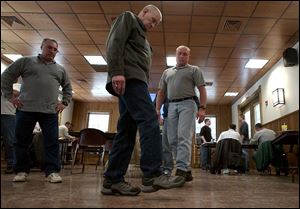
Police become subjects in DUI testing exercise
3/30/2005
Jeff Ciccone, left, a Maumee police officer, watches as Karl Ball, a volunteer subject, takes a field sobriety test administered by Jason Reel, an officer from Perrysburg, at Wildwood Preserve Metropark.
Sara Shaw had some drinks yesterday at Wildwood Preserve Metropark, a site that attracted a lot of people on a warm, sunny afternoon.
But Ms. Shaw wasn't drinking for pleasure. She was a subject in a training exercise for police officers learning how to use field sobriety tests to determine if a driver is impaired.
For Ms. Shaw, an Oregon police officer, the experience was a little unsettling.
Although she tested as being just over Ohio's legal limit of 0.08 percent blood-alcohol content, she said she was well outside the range where she would feel competent to drive.
She said it gave her a sense of how some people might think they can drive safely "because they've done it for weeks or months or years," but have been fortunate that a situation hasn't occurred that would test their ability.
Diane Mueller of the Oxford, Ohio, Police Department said the six volunteers who consumed alcohol yesterday were kept at or near the legal limit before they were each tested by a team of officers. "For some drivers, it's pretty easy to see that they are intoxicated. We're testing for those close to the limit," said Ms. Mueller, who is an instructor at the course.
She said she has arrested people who have tested below the legal limit, but were obviously impaired.
"You get some small person who isn't used to drinking and they may only test at 0.05, but I'd still arrest them if they were impaired," she said.
"There are two parts to the driving under the influence law, and only one of them has to do with blood-alcohol content," according to David Peters, who runs the police-training program.
Mr. Peters is a retired Ohio Highway Patrol lieutenant and an instructor at the Ohio Peace Officer Training Academy.
He said that no matter what blood-alcohol content is recorded, if a person performs poorly on field sobriety tests and has other indications of impairment a drunk driving charge can still be brought.
Police officers are taught to consider a person's age, general physical condition, and factors other than alcohol that might impede their ability to perform the tests.
Each volunteer drinker yesterday was tested by officers who had them walk heel-to-toe in a straight line and balance on one foot. Officers also tested their eye movement.
The officers were then to decide whether to "arrest" the individual and then write a report justifying their decision.
Mr. Peters said field sobriety tests are accurate in determining impairment to about 90 percent.
He acknowledged that some heavy drinkers may initially appear less impaired, but the tests can uncover the fact that they are under the influence of alcohol.
"We don't stop a drunk driver. We stop a driver because we've noticed a problem.
"The person might be ill, or lost, or tired. We stop them to find out what the problem is and then we address it," he said.
If the problem is that the driver has had too much to drink, Mr. Peters said, the only thing to do is get that person off the road.
"Strict but fair enforcement is a deterrence," he said, and that's what the program is designed to teach.
Sgt. Frank Arvay of Sylvania Township police, head of the local drunk driving task force, said about 20 officers are taking the 32-hour course, which will continue until tomorrow.
The training has been mandatory in Ohio police academies since January, 2000.
Programs such as the one under way at Wildwood take place regularly across the state for officers who didn't take the training earlier or who have been away from road patrol duty for some time.